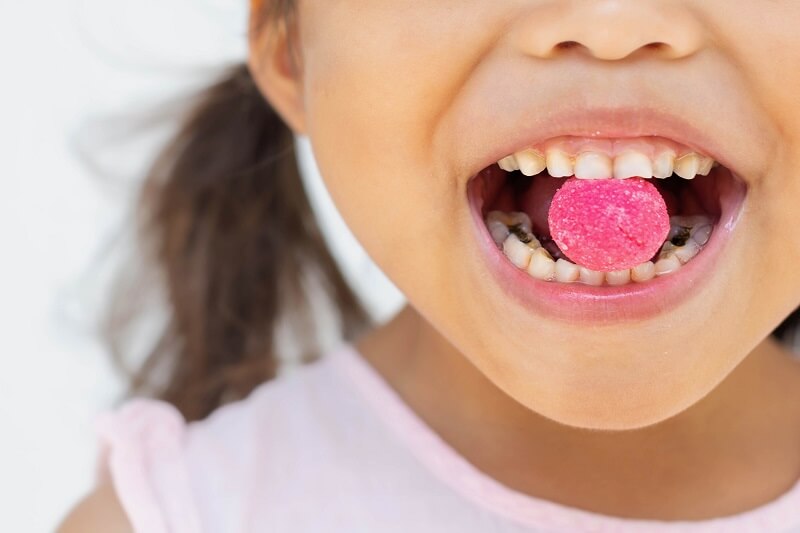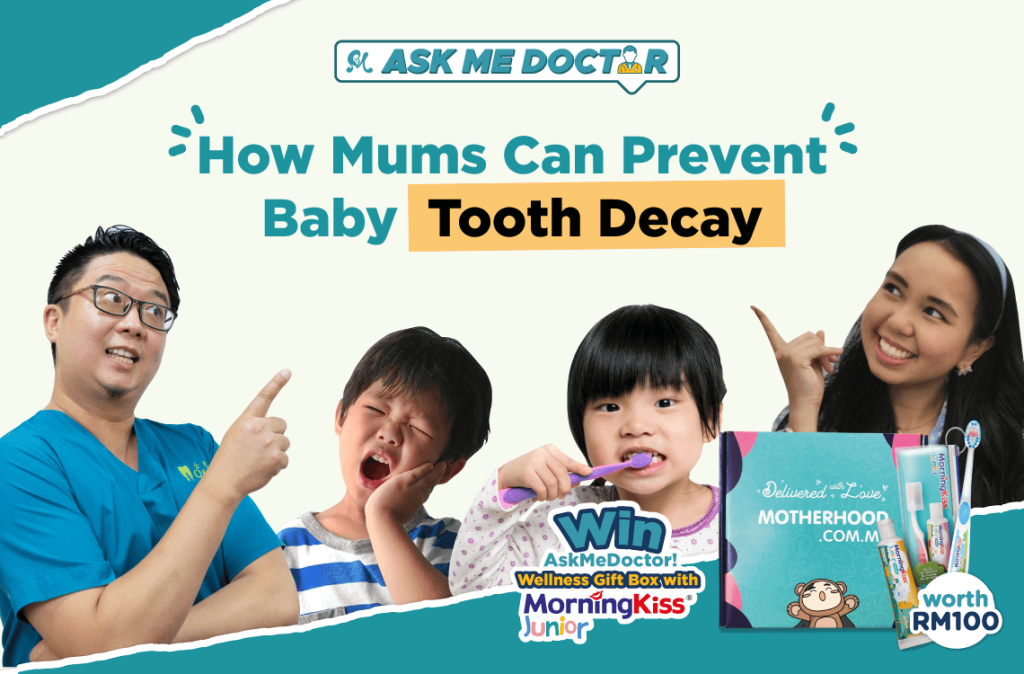What comes to mind when you think of tooth decay? I don’t know about you, but I remember when I was growing up, my parents would show me pictures of kids with rotten teeth to scare me into brushing my teeth and avoiding candy. But does tooth decay only happen because of having a sweet tooth?
Let’s get to the bottom of this with Dr. Tan Yi Han from Q&M Dental Clinic.

Q1. When do baby teeth appear?
Dr. Tan Yi Han: Usually, we would expect the baby teeth to come out at around six months of age. But in some babies, their teething tend to be a bit later, even before one year old is fine.
We need to be aware of one condition called neonatal teeth. This kind of situation happens when the baby is born, there is already the presence of tooth in his mouth.
So, it is good to have an Obstetrician and Gynaecologist to have a look, if not, you need to bring them to a dental clinic.
Usually, they are rootless teeth but can cause problems when the baby is suckling. It rarely happens, not very often, but sometimes it does happen.
Q2. What is baby tooth decay? How does it happen?
Dr. Tan Yi Han: Baby tooth decay is what we call early childhood caries. It happens when the tooth structure is losing calcium from the enamel and also from the dentin surfaces. How does that happen?
It’s because when we eat food or maybe when the babies are drinking milk; what happens is if you don’t cleanse them off soon enough and they are left for hours or even days, where all those carbohydrates or sugars inside our food or inside the milk, will turn into acid and then it will erode the surfaces of the teeth called enamel.
At first, it will appear as a whitish appearance, it’s like when you look at a block of ice, they are frosty. The teeth surfaces will appear like that at first.
And then slowly, what will happen is they will turn brown. In the end, it will become a hole, a cavity.
It’s the same kind of principle for toddlers as well. We don’t want the food debris or the milk to get stuck on the surfaces of the teeth for too long. So, the important thing, especially before sleep, is to not let the baby hold the bottle and fall asleep with that.
So, what you have to do is make sure after they had their milk, they have to drink water and also use a wet handkerchief to wipe the milk debris off or use a finger brush when they are above one year old.
Q3. Why are children more likely to have tooth decay?
Dr. Tan Yi Han: Children and adults have the same tendency to get tooth decay if we are not careful with how we take care of our oral hygiene.
In the case of children or toddlers, parents play a very big role in whether or not their kids get tooth decay. Because most importantly; how you take care of your teeth, the method you use to take care of your oral hygiene determines whether or not you get tooth decay.
Babies, toddlers, and children, they don’t have this awareness of oral hygiene. They just want to play and have fun. When they are tired, they just want to sleep.
They don’t know what is oral hygiene and they might not like having something in their mouth. So, parents sometimes have to kind of force the routine on them else they have a higher tendency to get tooth decay.
Q4. What are the symptoms of tooth decay?
Dr. Tan Yi Han: I’ll explain it from the initial part until the most severe part.
Firstly, you will notice the tooth surface becomes frosty white, it’s not shiny. It becomes a matte surface and then slowly, it will turn brownish that can’t be brushed off. And if you leave it there, sooner or later it will become a cavitation or a hole, that is when we have to do fillings on it.
If it’s still not managed at that stage, it will progress into a nerve infection where the kid will experience toothache. Even worse, they may develop abscesses and a bit of swelling over there. That is when the kid cannot sleep, and even parents cannot sleep then.
Q5. What should we do if there’s decay?
Dr. Tan Yi Han: Decay may have started from the frosty white parts, but when it progresses into a cavitation or a hole, there’s nothing much parents can do except to bring them to dental clinics to do a filling.
Because once a hole has formed, food debris and bacteria will get stuck inside and will make the situation worse. The hole will get bigger and bigger. And slowly it will invade the nerve region and cause toothaches to the kid.
Q6. How can we prevent baby tooth decay?
Dr. Tan Yi Han: The most important factor in oral hygiene is brushing. Often, we would let it go—because we see the baby is lying down, we see our toddler is lying down, we don’t want to wake them up to brush their teeth anymore, right?
Actually, we have to be a bit stern and wake them up to brush their teeth. Then only, they can go to sleep. That’s the most important thing.
And of course, parents themselves have to constantly or weekly take a look at their children’s mouth and when you see anything unusual is happening, you should bring them in.
And also, let the dentist have a look every 6 months or at least once a year. Even though they don’t have any cavities, no complaints, you should bring them in for a regular checkup and maintenance.
Let the dentist do some polishing, maybe scaling or maybe applying some fluoride gel for cavities prevention. And also most importantly, let them be familiarised with dental settings.
When you do all these steps correctly, definitely there will be minimal risk for tooth cavity to happen and your kid will not suffer.
I would say in our current society, we are unable to run away from sweet foods. The culprit of tooth cavities is not only sweet foods and sweet treats like candies and so on. It is also from carbohydrates.
Whatever foods that are made from flour, rice even noodles, bread, biscuits, if we are not careful, they get stuck in our oral cavity and if you don’t brush them off, even if you think they are not sweet, once they are processed with bacteria, the carbohydrates will break down into sugar and sugar will be broken down into acid. That is when the tooth cavities happen.
How to brush your children or toddlers’ teeth?
So, once they are able to follow the instructions of spitting, you can introduce them to toothpaste. If they do not know how to spit properly, you can use a toothbrush or a fingerbrush in order to brush their teeth.
The best method is to separate the top and bottom teeth and brush them separately. And when you brush, you go in circles.
Don’t go in and out, left and right. Instead, go in circles and align the brush 45° towards the gums to allow the brush bristles to move on the tooth and gums’ junction and clean them properly.
Make sure you clean all the surfaces including the outside surfaces, the inside surfaces as well as the biting surfaces. And of course, don’t forget the end of the molar teeth or the big teeth.
Make sure you go all the way to the end because children sometimes do not like foreign objects in their mouth, and when you touch the back areas, they gag and they tend to spit out. But try to make it a habit, to go all the way to the end.
Pay attention that you have to brush your teeth for two minutes. Spend more time brushing. Two minutes is actually longer than you think.
Of course, you can put a phone in front of you and look at the timer. Or use a song; the classic song Yesterday by The Beatles is almost exactly two minutes long and is the perfect song for tooth brushing.
So what you can do is: Bring your phone in, load up YouTube, play the song, put it in front of you and start brushing. Only stop brushing when the song finishes.
Protect Your Kids Teeth With MorningKiss Junior MOPEA Starter Kit
MorningKiss Junior MOPEA Starter Kit is your kids’ perfect start to healthy oral care. It is gentle on growing gums, contains no SLS, Parabens, Fluoride and Saccharin and is very convenient for kids and parents! MOPEA is every kids’ dental best friend. When MOPEA is around, you can always count on him to make oral care a fun time for your kids.
Buy MorningKiss Junior products from these links below today:
- Shopee: https://bit.ly/3IcxN2J
- Lazada: https://bit.ly/3JOevRW
We hope you’ve gained some valuable tips on how to look after your children’s teeth from Dr. Tan Yi Han. Stay tuned for more insights on dental care and more with our next AskMeDoctor! episode.
Disclaimer: The information provided in this article is for informational purposes only and should not be considered as medical advice from Motherhood. For any health-related concerns, it is advisable to consult with a qualified healthcare professional or medical practitioner.
Disclaimer: The information provided in this article is for informational purposes only and should not be considered as medical advice from Motherhood. For any health-related concerns, it is advisable to consult with a qualified healthcare professional or medical practitioner.
For more insightful stories and fun recipes, stay tuned to Motherhood Story!
